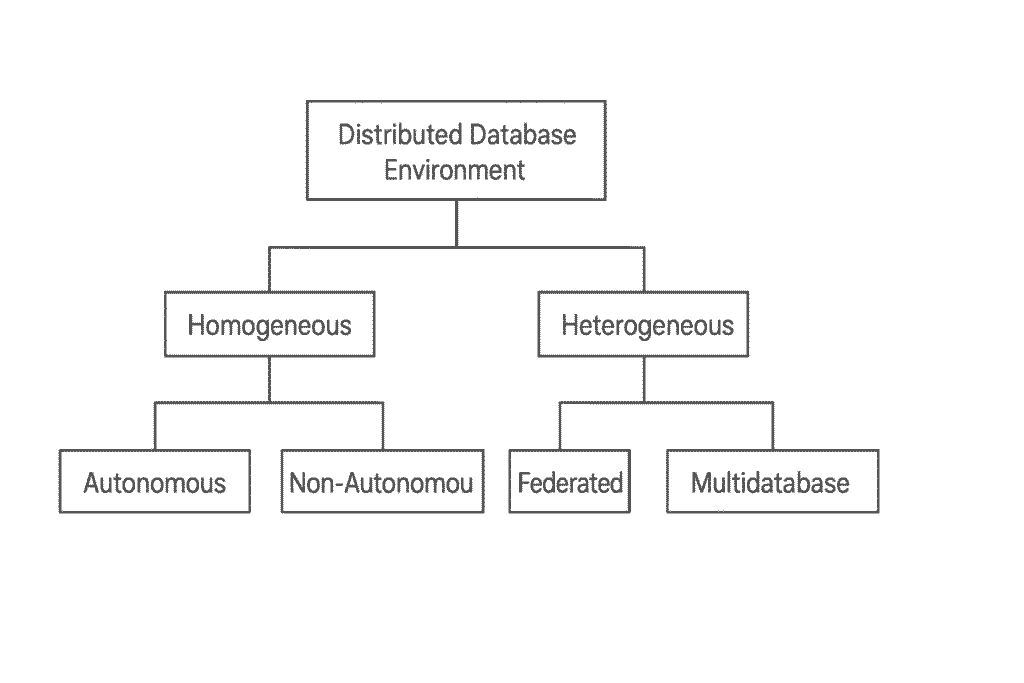डिस्ट्रिब्यूटेड डेटाबेस क्या होता है? | Distributed Database in Hindi
आज डेटा केवल एक कंप्यूटर या एक सर्वर में नहीं रहता। बड़ी कंपनियाँ, बैंकिंग सिस्टम, सोशल मीडिया, ऑनलाइन शॉपिंग और मल्टी-ब्रांच संस्थान एक ही डेटा को अलग-अलग लोकेशनों से इस्तेमाल करना चाहते हैं। इसी आवश्यकता ने Distributed Database System को जन्म दिया।
Distributed Database क्या है? – Distributed Database in Hindi
Distributed Database वह डेटाबेस सिस्टम है जिसमें डेटा एक ही स्थान पर संग्रहित नहीं होता, बल्कि नेटवर्क पर मौजूद कई अलग-अलग कंप्यूटरों या सर्वरों में स्टोर किया जाता है। इन सभी डेटा स्टोरेज साइट्स के डेटाबेस आपस में DDBMS (Distributed Database Management System) द्वारा नियंत्रित और सिंक्रोनाइज़ किए जाते हैं।
सरल भाषा में, एक ऐसा डेटाबेस जो कई जगह बंटा हो लेकिन उपयोगकर्ता को एक ही डेटाबेस की तरह दिखाई दे।

Distributed Database की विशेषताएँ (Features)
| Feature | Explanation |
|---|---|
| Logical Connectivity | सभी डेटाबेस logically जुड़े होते हैं |
| Physical Distribution | डेटा physically विभिन्न सिस्टम पर स्टोर होता है |
| Not a Simple File System | केवल file storage system नहीं |
| Network-Based Access | सभी sites communication नेटवर्क से जुड़ी होती हैं |
| Local Autonomy | हर site अपने local data को खुद नियंत्रित कर सकती है |
| Global Application Support | सिस्टम एक global application भी चलाता है |
Goals of Distributed Database System
Distributed database को बनाने के मुख्य उद्देश्य –
| Goal | Benefit |
|---|---|
| Reliability | एक site fail हो जाए तो दूसरा सिस्टम काम करता है |
| High Availability | सिस्टम हमेशा available रहता है |
| Better Performance | Data नज़दीक होने से processing तेज |
| Location Independence | डेटा को कहीं से भी access किया जा सकता है |
Types of Distributed Database – डिस्ट्रिब्यूटेड डेटाबेस के प्रकार
Distributed DBMS को दो प्रमुख श्रेणियों में बाँटा जाता है:

Homogeneous Distributed Database
इस मॉडल में सभी साइट्स एक ही प्रकार के DBMS, same Operating System और same data model का उपयोग करती हैं।
विशेषताएँ:
- सभी sites एक-दूसरे को पहचानती हैं
- Data का sharing और update आसान
- Query execution fast
Homogeneous DB के प्रकार:
| प्रकार | विवरण |
|---|---|
| Autonomous | हर site स्वतंत्र लेकिन सहयोगी |
| Non-Autonomous | एक central control system द्वारा नियंत्रित |
Heterogeneous Distributed Database
इसमें अलग-अलग DBMS, OS, schemas और data models का प्रयोग होता है। उदाहरण के लिए, किसी साइट पर MySQL और दूसरी साइट पर Oracle हो सकता है।
चुनौतियाँ:
- Query processing complex
- Transaction management कठिन
- Data translation की जरूरत
Heterogeneous DB के प्रकार:
| प्रकार | विवरण |
|---|---|
| Federated | Sites loosely integrated |
| Non-Federated | Sites partially integrated और पूरी तरह dependent |
Advantages of Distributed Database
| लाभ | विवरण |
|---|---|
| High Reliability | Failure होने पर दूसरे nodes मदद करते हैं |
| Availability | Server down होने पर भी system active रहता है |
| Fast Access | नज़दीकी डेटा को access करने पर speed बढ़ती है |
| Low Operating Cost | Local access और distributed processing से saving |
| Scalability | नए sites आसानी से add किए जा सकते हैं |
| Transparency | उपयोगकर्ता को database एकीकृत रूप में दिखता है |
Disadvantages of Distributed Database
| नुकसान | कारण |
|---|---|
| High Complexity | Architecture बड़ा और जटिल |
| High Setup Cost | Setup और maintenance costly |
| Security Challenges | एक से ज़्यादा sites की security कठिन |
| Difficult Integrity | डेटा को exactly sync रखना मुश्किल |
| Extra Tools Needed | Backup, recovery और translation tools आवश्यक |
इन्हें भी पढ़े –
- DBMS क्या है DBMS के प्रकार और कार्य की पूरी जानकारी | DBMS In Hindi
- डेटाबेस यूजर्स क्या है?
- डेटा इंडिपेंडेंस क्या है
- DBMS के लाभ
- Characteristics Of DBMS In Hindi
- डेटा मॉडल क्या है?
- डेटाबेस स्कीमा क्या है
- इंस्टैंस क्या है
- डेटाबेस इंटरफ़ेस क्या है
- डेटाबेस लैंग्वेज क्या है
- Classification of DBMS in Hindi
- Entity Set in DBMS
- DBMS Architecture in Hindi
- Types of Data Models in Hindi
- Attributes in DBMS in Hindi
- Entity Set in DBMS (Hindi)
- Entity Types in DBMS (Hindi)
- Types of Attributes in DBMS
- ER Model in DBMS (E-R मॉडल) क्या है?
- Entities के बीच संबंध
- Domain in DBMS
- Tuples in DBMS
- SQL में Joins क्या हैं?
- Primary Key in DBMS
- DBMS Keys in Hindi
- DBMS Data Integrity in Hindi
- Relational Algebra in DBMS
- Normalization in DBMS क्या है?
- BCNF (Boyce-Codd Normal Form) in DBMS
- Functional Dependency in DBMS
- Non-Loss Decomposition in DBMS
- SQL Data Types in Hindi
- Create Table in SQL in Hindi
- SQL DROP TABLE और ALTER TABLE in Hindi
- SQL Indexes in Hindi
- SDLC in Hindi
- DBLC in Hindi
- SQL Views in Hindi
- PL/SQL PROCEDURES in hindi
- Database Normalization in Hindi
- Domain Key Normal Form in Hindi
- SQL Objects in Hindi
- Aggregation, Generalization, Specialization and Association in Hindi
- Data Dictionary क्या है?
- डेटा वेयरहाउसिंग क्या है?
- डाटा माइनिंग क्या है?
- File Organization in Hindi DBMS
- Relational Model in Hindi – रिलेशनल मॉडल क्या है?
- RDBMS Applications in Hindi
- MySQL क्या है?
- Parallel Database in Hindi
निष्कर्ष –
Distributed Database उन संगठनों के लिए सबसे महत्वपूर्ण तकनीक है जो —
- बड़े स्तर पर डेटा हैंडल करते हैं
- कई locations पर operation चलाते हैं
- High availability और fast access चाहते हैं
DDBMS, आधुनिक IT सिस्टम की backbone है।
